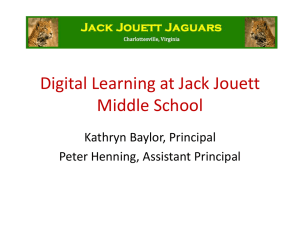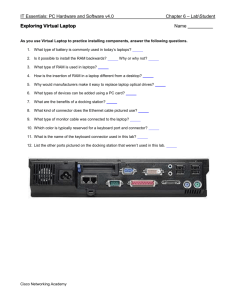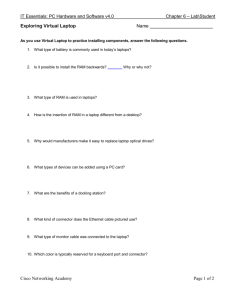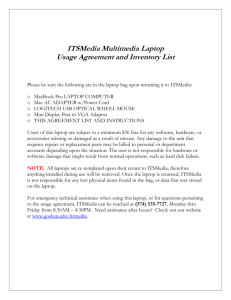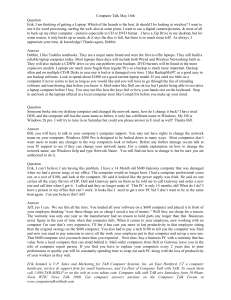How Students Learn
advertisement
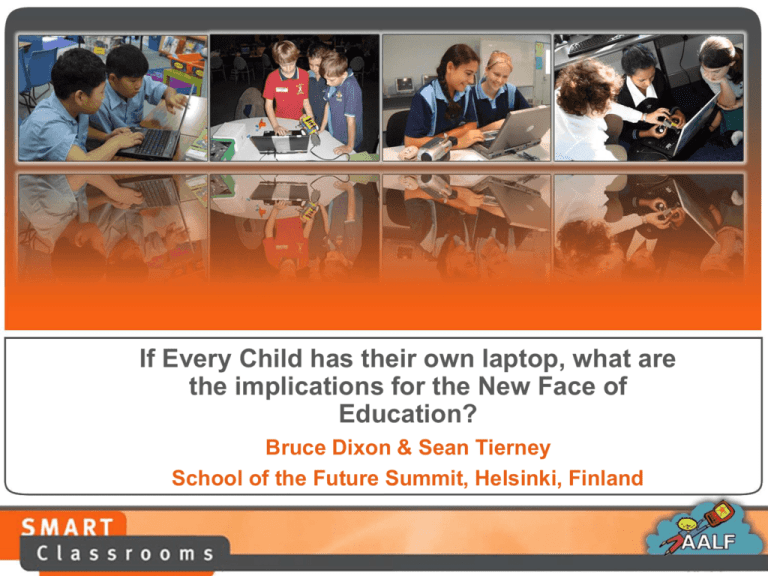
If Every Child has their own laptop, what are the implications for the New Face of Education? Bruce Dixon & Sean Tierney School of the Future Summit, Helsinki, Finland A vision of learning built around a very powerful idea... “More and more I was thinking of the computer not just as hardware and software but as a medium through which you could communicate important things. ….an instrument whose music is ideas. The best thing a teacher can do is to set up the best conditions for each kid to learn. Once you have that, then the computer can help immeasurably. Conversely, just putting computers in the schools without creating a rich learning environment is useless -- worse than useless!” http://www.honco.net/os/kay.html 21st Century Learning Ingredients Digital Curriculum Improved Learning Methods Technology eLearning Environments Professional Development Connectivity eLearning Ingredients Digital Curriculum Improved Learning Methods Tec Improved Learning Methods hno Professional Development logy Professional Development Digital Curriculum Connectivity Technology Connectivity eLearning Environments Learning Value 1:1 eLearning Classroom eLearning PC Labs Basic ICT Digital Curriculum Improved Learning Methods Professional Development Connectivity Technology Why consider One-to-One? Equity-Narrows the Digital Divide? Economic-budget imperatives? Unlocks the possibility of personalised learning? Improves assessment alternatives? Provides opportunity for textbook replacement? Marketing-competitive advantage? Expanded pedagogical opportunities? Research on the impact on learning? Offers 21st Century Learning opportunities -extends formal learning communities and expand global communication and collaboration, and develop creative expression ..offering more compelling learning experiences for all students. A one-to-one initiative …every student with their own laptop..why not? Where will the funding come? How can we make it happen? ..build equity not inequality! A simple idea that just might work! Why is it important for each child to have a computer? What's wrong with community-access centers? “One does not think of community pencils— kids have their own. They are tools to think with, sufficiently inexpensive to be used for work and play, drawing, writing, and mathematics. A computer can be the same, but far more powerful. ….and these belongings will be well-maintained through love and care.” Nicholas Negroponte 2005 a shift in focus.. Learning will not take place only inside schools and colleges, but in communities, workplaces and families. The shift to thinking about learning beyond the classroom requires a shift in our thinking about the fundamental organizational unit of education…from the school, an institution where learning is organized, defined and contained… …to the learner, an intelligent agent with the potential to learn from any and all of her encounters with the world around her. Tom Bentley, 1998 Transformative Teaching & Learning… • Assists in creating collaborative learning communities connected in unique and exciting ways. • Allows us to build compelling models for using technology to improve the learning experiences of students. • Allows us to explore new directions and more challenging and rigorous concepts: • Integrates a range of teaching tools providing an effective learning support and accountability framework • Allows us to offer true differentiated instruction to individual students, to teach one student, at a time, and provide a more effective, powerful learning experience for all. 44 A different view of the nature of learning • Anyone can now learn anytime, throughout their life • Anyone can now learn anywhere, wherever one has access to the Internet • Anyone can now learn anyhow, in tacit, non-formal and formal ways • So, learning need not, and perhaps even should not, be concentrated in a given period of life (school age) and in a particular place (the school) nor ought it to be “standardized”, “one size fits all” 19 What does the research tells us about how technology enables improved learning opportunities for our students?… What the research tells us… • Student attendance increases and students are more motivated and more engaged (Russell, 2004, New Brunswick, 200406) • Students write more, more often and better. (Silvernail, 2004, Warschauer, 2005) • Overall improvement in test scores (New Brunswick, 2004-06 +) • Students engagement in critical thinking, problem-solving, and higher-order thinking on a task increased with 1-to-1 students; more willing to address/assess controversy within an assignment (Rockman, 1998) What the research also tells us… • Increase in 21st century learning skills – including multimedia engagement, greater quality/quantity of writing, multiple/deeper investigation of information (Warschauer, 2005) • Motivation, engagement, independent work, interaction, and class preparation/participation of students with disabilities improved (Harris, 2004) • Access to a laptop for teachers and their students often forced a change in teachers’ level of risk and openness to learning (Rockman, 1997) • As digital confidence grows, and teachers are more ambitious… • • • More students are accessing more mathematics in deeper ways. Students explore new dimensions of accessing new knowledge Students are more engaged in in-depth research (Warschauer, 2004) What the research tells also us… • Teachers perceive that students exhibit a range of learning behaviors that are better because of the laptops (Silvernail, 2004) • There is a greater level of effective delivery to students with special needs and individualized learning programs. (New Brunswick, 2004-06) • There is a statistically significant change towards a constructivist teaching practice; teachers indicated the laptops were important in making these changes (Rockman, 2000) • Teachers’ attitudes and beliefs significantly affect implementation and success (Penuel, 2005) The research we (very much) look forward to… • More evidence of how 21st Century/digital pedagogy will improve learning outcomes for all students • What attributes of leadership best enable the development of a contemporary learning culture within a school • What is Assessment 2.0 ? -new metrics for learning that better reflect the needs of the 21st Century. • Detail on the most effective programs that build significant change in teaching practice …and, just how far student’s learning can go… when they are given the Freedom to Learn! Standard Question 1 “Our school wants to start a student laptop program.. Which ones should we get?” Standard Question 2 What data do you have that will help us convince the staff / admin we need a laptop program? Standard question 3 What do you mean “What is our VISION for our student laptop program?” Seeing No Progress, Some Schools Drop Laptops Scores of the leased laptops break down each month, and every other morning, when the entire school has study hall, the network inevitably freezes because of the sheer number of students roaming the Internet instead of getting help from teachers. So the Liverpool Central School District, just outside Syracuse, has decided to phase out laptops starting this fall, joining a handful of other schools around the country that adopted one-to-one computing programs and are now abandoning them as educationally empty — and worse. “After seven years, there was literally no evidence it had any impact on student achievement — none,” said Mark Lawson, the school board president here in Liverpool Components of a successful 1-to-1 initiative Components of a successful 1-to-1: Components of a successful 1-to-1: School Readiness: Consider: Technical Support Physical Security Connectivity Learning Environment Wireless Access Staff Readiness Network Storage Parental Support Power Supply Community Support Security Leadership Support Baseline Project Plan: What is a realistic, manageable timeline? What are the project priorities? How will change be managed? How are the project tasks divided? What is the communication strategy? What are the policies & procedures to be defined? Baseline Project Plan: Baseline Project Plan Components of a successful 1-to-1: Pedagogical Reform: An ongoing Process involving structured Professional Development around: Re-Imagine Curriculum Opportunities Examining new learning possibilities enabled by technology How to model and replicate best practice Exploring new forms of assessment How technology can enable constructivist learning What new benchmarks can be set Components of a successful 1-to-1: Technology for Teachers: Underpinned by structured Professional Development Teachers need to be comfortable with the technology prior to students having devices Improves teacher professional productivity Enables development of 21st century learning resources Basic Software Issues: Set curriculum objectives, then find software tools to match Cohort specific requirements Imaging (Ghosting), Upgrade Management, SOE, compatibility Licensing: MEA, Virus Protection, System Licenses Software Registry External Software Policy Supporting Technology : Components of a successful 1-to-1: Student Laptop Deployment: Implementation Models Purchasing Models (Consider software licensing, equity etc.) Phased Implementation (by grade or class) e.g. Year 7 and 9 Whole of School Implementation Timetabling (mixed classes / laptop only classes) Device Registry / Delivery / Timing External Software Policy Supportive Policies: Examples Security / Storage (lunch time, sport, after school etc.) Games / Chat Service / Support (pricing & limitations) Flat batteries / Swap-out batteries Backup / recovery Device Flexibility / Options Role of Parents / Mandatory training? Other considerations: Selecting a device fit for purpose (PSA v local relationships) Insurance regulations What is the professional development plan? How are the project tasks divided? What is the communication strategy? What are the policies & procedures to be defined? Communication Strategy: Involve parents, staff, students, P&C / P&F and broader community in planning stages Be transparent Set realistic expectations Provide information / education to all stakeholders Proactively celebrate successes Summary 1. Recognize that digitalizing a didactic approach to learning is NOT the answer: • Technology is NOT a replacement for textbooks 2. Consider technology as a TOOL for bringing about desirable attributes of learning: •Independent, self directed learning •Higher-level critical thinking •Problem Solving •Collaboration / teamwork •Modelling the world the students are inheriting 3. Get it right.. Financing 1-to-1 Within 5 - 7 years, conventional whiteboards and blackboards will be more expensive than high definition interactive screens per square inch One-to-One Funding Equity Core Principles • Funding should ensure all students can participate • Everyone who benefits should make some contribution • Funding should be structured to ensure it can be sustained indefinitely • Laptop funding must be supported by a commitment to professional development A unique funding option… School Shared Cost Model Fluid …that is sustainable, replicable and scalable. Start with some assumptions…. • Student laptop Total Cost $850 $1100 Over 3 years $32/month • Bag $50 • 3 years insurance $150 Software * $50 A unique funding option… School- 5%-$1.60 Shared Cost Model $32/month Fluid …and this is sustainable, replicable and scalable…every child can benefit. An alternative…. • Intel Classmate Total Cost $450 $600 Over 3 years $17/month • Bag* $30 • 3 years insurance $70 Software * $50 A unique funding option… School-10%-$0.87 Shared Cost Model $17.45 month Fluid …and this is sustainable, replicable and scalable…every child can benefit. The unconnected classroom / learner during school time occasional expert visits school community occasional class excursions teachers school library snail mail mobiles, phones, fax machines, TV, video The connected learner any where ~ any time ~ in time Primary sources Secondary sources writers original artefacts and documents people’s experience learning communities world libraries and museums online learning websites experts organisations collective thinking digital repositories Unis/Colleges all teachers any school RSS feeds speakers peers collaborative projects original works networks original photos, images, video, audio learning objects world news world events common interest groups action learning groups global groups commercial companies Carr 2006 MOO chat forum wikis blogs LMS CMS podcast data/tele/video conferencing messaging email & listservs video cast/streaming webcasts meeting tools web authoring mobiles, phones, WAP, VOIP, PDAs, tablets, desktop, laptop, future technologies Creating a district-wide wireless broadband could mean… • Access for students within and outside their classrooms and their schools. • Minimal access costs built into the computing costs ? eg $4-5 per month for unlimited* access anywhere in the District • Opportunity for cost recovery through universal student contribution and extended access for business. • An emerging business model that should have applicability to other schools across the State and beyond. www.aalf.org
